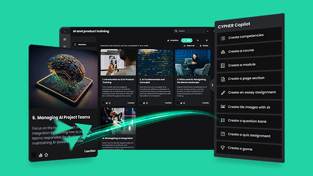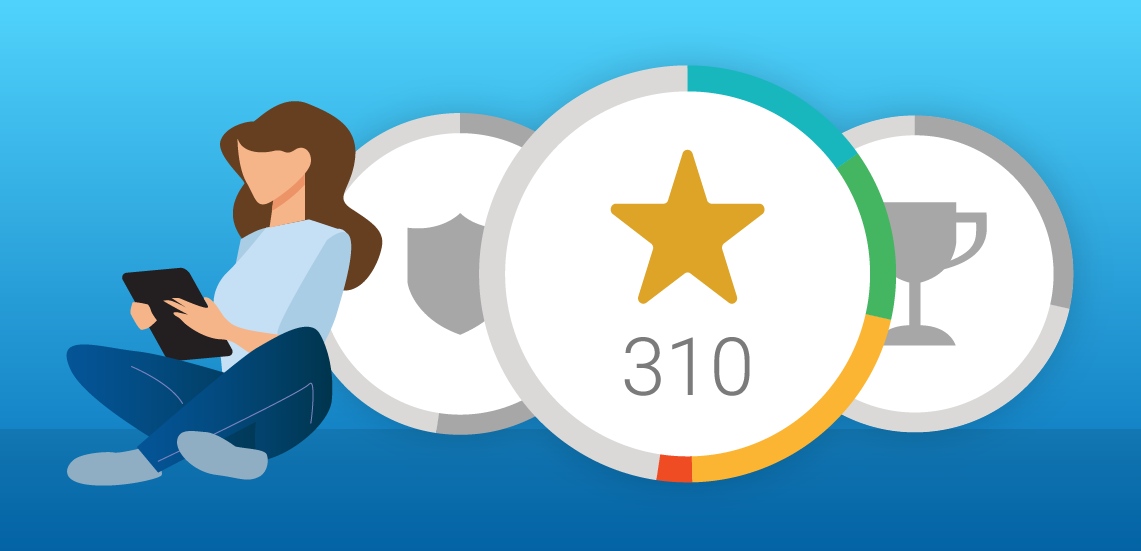For learning to be efficient and produce long-lasting effects, it should be engaging. The more learning resembles a game, the more appealing it will be, which is the concept behind gamification. Competitions, leaderboards, and awards are important gamification elements. However, a classroom gamification level system takes the gamified learning experience a step further.
This type of system allows teachers to easily walk students through their classes and evaluate them in a fun way. Thus, learning turns into an interactive and immersive experience and evaluation looks more like a challenging competition than a traditional assessment. There are many benefits to gamifying your classes, especially if you can easily do this through a learning management system (LMS).
Let’s delve deeper into the advantages of the classroom gamification level system and how you can set it up.
Why set up a classroom gamification level system?
Gamification in education has different benefits such as increased student engagement, a higher level of collaboration, and an easier way to track student progress. The purpose of gamification in the classroom is to boost students’ interest and motivation. Hence, progressing through levels is an essential part of this.
Increase student motivation
Students love games. Just think about the amount of time some of them spend playing computer games. By making gamification work through a level system, you can turn learning into something that resembles a game quest.
Promote a fun, competitive spirit
In a gaming environment, players can join a community or tournament. There, they share insights, recommendations, or challenge each other to see who manages to climb higher up the leaderboard. Teachers can use the same competitive approach in the classroom by using competency levels and leaderboards.
Enhance collaboration
Moreover, activities that rely on gamification can also enhance student collaboration, especially if you divide your students into groups and establish an award for the winning team. The award can be collective or individual.
Better information retention
By setting up a gamified LMS assignment that involves levels of competency, badges, and awards, students have a more positive perception of their learning environment. Games are not as daunting as tests and worksheets. Therefore, they lead to a more pleasurable and beneficial learning experience.
As a result, information retention also becomes more efficient and lasting. More so, gamified classes usually make massive use of photo, video, and audio content, all of which stimulate the memory and lead to higher information retention.
A different evaluation and results tracking process
The evaluation process plays an important part in how students perceive academic success. For example, repeating a negative evaluation experience, or getting bad grades can ultimately lead to a mental block. This makes students think they simply don’t have what it takes to learn.
So, if a traditional test makes students nervous, why not approach evaluation from a gamified experience? An experience in which they momentarily forget about the pressure and get immersed in a task.
Read more: 5 Ways to mix education and entertainment in the classroom
How to set up a classroom gamification level system
A robust gamification teaching strategy not only includes incentives such as points and badges but also relies on a classroom gamification level system. As its name suggests, such a system involves several competency levels. As a teacher, you’ll have no problem figuring out which level corresponds to the different parts of your classes.
Therefore, the only part you should be focusing on is implementing the classroom gamification level system. How will you walk students through the different levels while enabling them to acquire new knowledge? More so, you should also constantly evaluate them along the way with the help of gamification.
A learning management system (LMS) is the easiest way to achieve this. Many LMSs already have in-built gamification levels among their features. Therefore, you just have to adapt them to your objectives.
1. Create the game
LMS gamification is based on automation, a feature that enables you to trigger actions such as awarding badges or points to students upon completing certain tasks. You can create class games and customize them in order to incorporate certain themes.
The purpose of LMS games is to help students achieve mastery of a topic in a fun and motivating way. LMS gamification enables you to do this by challenging students to collect points or badges or climb leaderboards as they learn. The latter is a competitive feature that will motivate students to learn more in order to position themselves at the top of their class rankings.
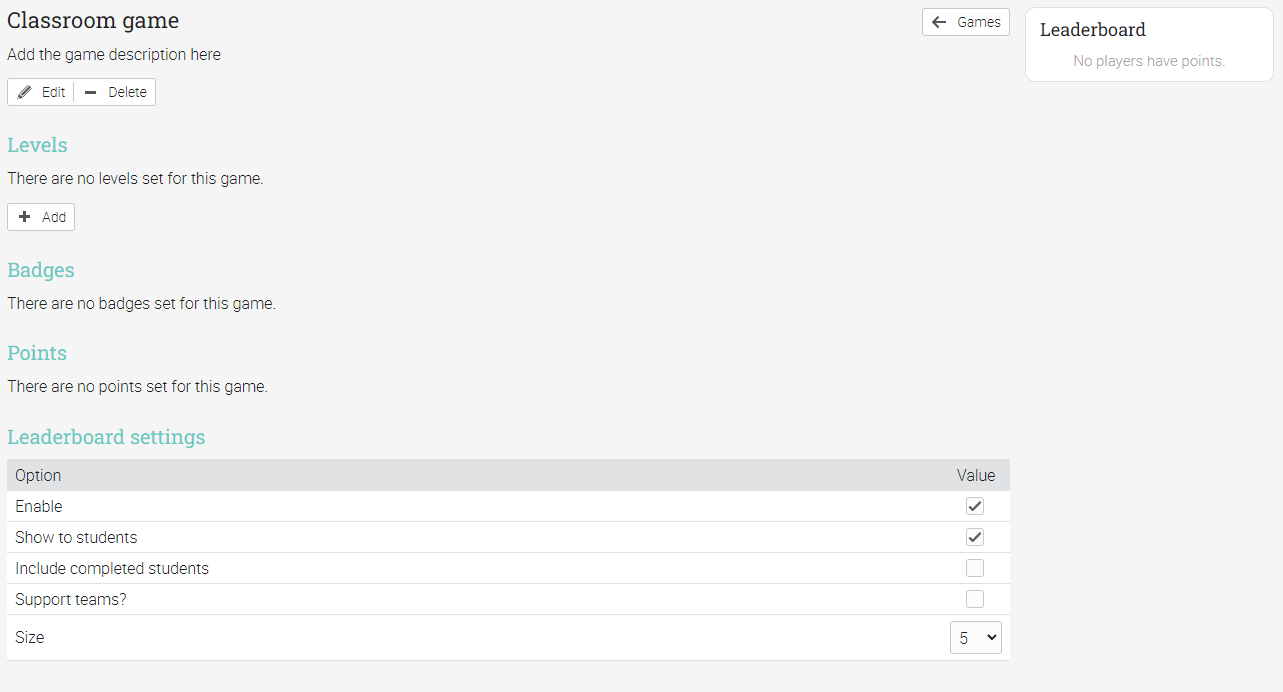 Games are easy to create and consist of levels, points, badges and leaderboards.
Games are easy to create and consist of levels, points, badges and leaderboards.
Each game you create will consist of multiple levels with correspondent points benchmarks, prizes, awards, and leaderboards. All these details, along with the number of participating students, their scores, rankings, etc. will show up on the dashboard.
To make things more exciting, you can also create team games and engage different student groups in fun contests. In this case, the leaderboard will display team results. Naturally, you will also be able to view each student’s individual contribution to the game.
The game creation process is relatively simple as most LMSs offer gamification guides and other resources to help you out.
Read more: How to make learning engaging with gamification
2. Map out the game
Before you start creating a classroom gamification level system in your LMS, you need to have a concrete plan. This means you should be mapping your game first. It’s useful to have this plan written down.
Basically, you’ll choose how many points students need to gather to pass from one level to another. Also, determine how you will award badges. For example, once a student completes a short quiz, they can gain 10 points. A longer quiz can lead to 20 points or a badge. The idea is to avoid situations in which simple assignments get more points than more challenging ones.
Alternatively, you can also perform a simulation in the LMS to see how the system works if you already have students enrolled in the class. Just create a class template or copy the class to test the gamification levels and maybe enroll just one student, teacher or teaching assistant so they can give you feedback.
By mapping out your game, you establish which actions students need to take to progress through the level system. You also establish which actions trigger awards and in what form. Having this plan before configuring the LMS game levels will speed up your work.
3. Create the levels
In the image below, you can see that there are four distinct levels and corresponding points. The LMS already provides you with this structure. You get to choose how many points each student must accumulate to level up. The points are the direct result of the challenges and assignments students must complete on the platform or in the class.
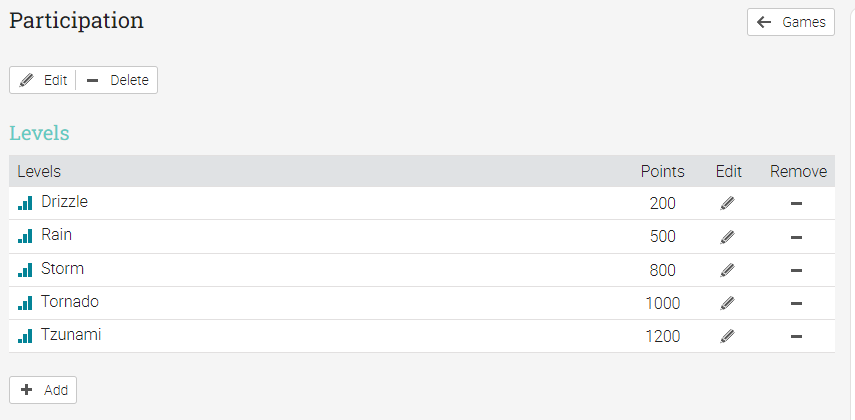 Students reach each game level by accumulating points and earning badges.
Students reach each game level by accumulating points and earning badges.
You can also set zero points for the beginner level if students are just starting their journey. Alternatively, you could ask students to take traditional written tests. Then, convert their grades into points and enter them on the platform to enroll students in classes based on their level or help them move up to the next one.
If you want to make the whole level system more student-friendly, you can even use different names for each level. For example, someone who’s barely getting started can be a novice, while an expert can be a master. You can choose all sorts of creative names to make students feel more eager to conquer a new title and less overwhelmed if they get stuck at the beginner level for a long time.
3. Choose the awards
Finally, since the whole purpose of gamification in the classroom is to make students more engaged in their learning, it’s recommended to think about the rewards they get once they achieve the desired level.
There are symbolic rewards such as points, badges, or course certificates students receive within an LMS. Alternatively, higher education students can get coupons which they can later use to purchase other courses in the learning platform.
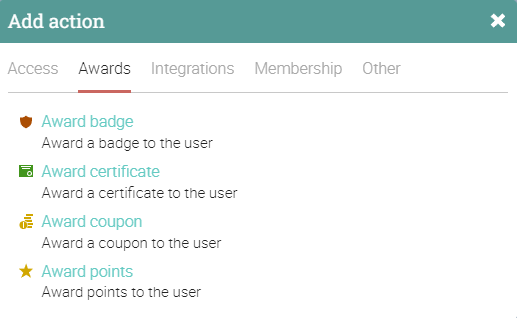 Add points and badges to make learning more fun.
Add points and badges to make learning more fun.
However, you can also send students automatic messages when they’ve reached a new level, so they also get this type of feedback and validation from you:
 All students can get an automatic congratulatory message when they reach a new level.
All students can get an automatic congratulatory message when they reach a new level.
4. Choose the class areas
The classroom gamification level system above can be tailored to any type of class. Moreover, you can also choose what happens when each level is achieved. For example, students can automatically receive a new badge. In an LMS, these are different rules you can add after creating the game levels to reward students when they complete different tasks.
There are different class areas where you can use automation to set up these rules, such as:
- Student enrollment or unenrollment actions: students get badges automatically when they are enrolled/unenrolled in or from a class;
- Class completion: students receive certificates or badges when they complete a class;
- Task completion: students receive awards when they submit assignments.
More so, you can also configure score-based actions. For example, students who manage to score above 90 percent on a quiz get a special badge or award. Level actions, on the other hand, are triggered when a particular level is reached by collecting the minimum number of required points.
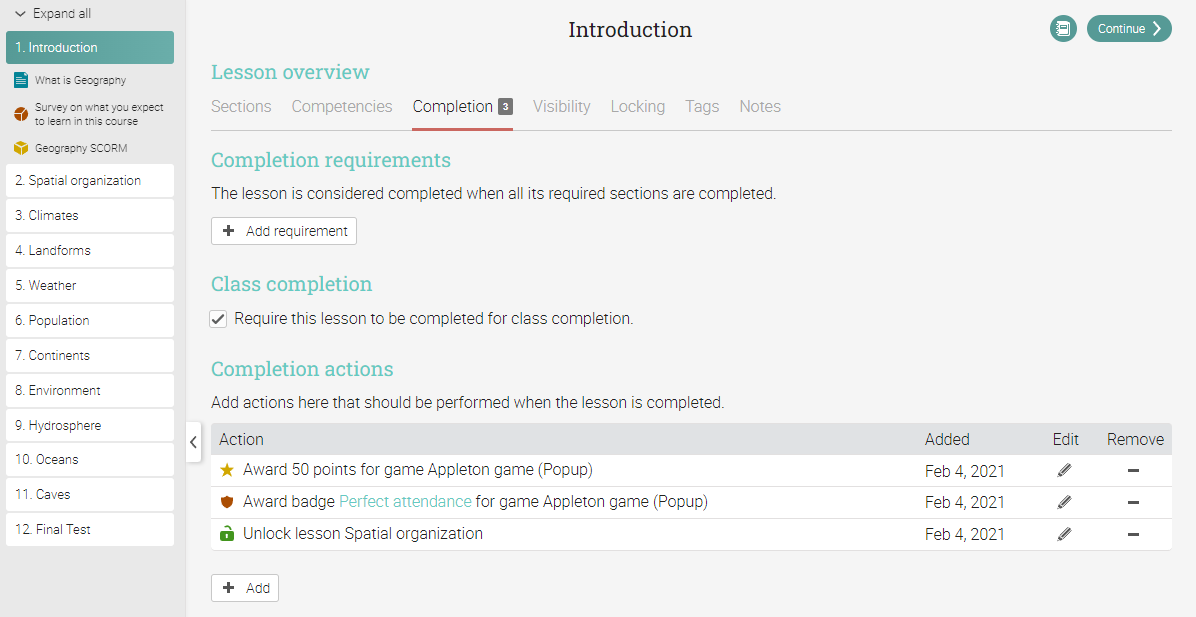 Students that complete this particular lesson get 50 points and a badge for Perfect attendance.
Students that complete this particular lesson get 50 points and a badge for Perfect attendance.
Read more: How teachers can make the most of LMS automation
5. Students’ overview of their progress
Now that you know how to set up a classroom gamification level system, there is one more aspect to focus on – students’ overview of their progress. When playing a game, students want to see their progress in real-time. Knowing how many rewards they’ve collected motivates them to complete the game faster.
The same applies to an LMS gamified level system. Students need to know where they are and what they have to do to advance to the next level.
 If you use LMS gamification tools, you can enable the leaderboard feature.
If you use LMS gamification tools, you can enable the leaderboard feature.
Student dashboards show their progress, the number of points or badges they’ve gathered, individually or as a team, and how many points they still need to reach the next level, as well as the class leaderboard.
Conclusion
There are many reasons why classroom gamification level systems work. Students are more likely to want to complete an assignment or class when there’s an award waiting at the end or if the goal is to pass from level A to level B.
Gamification makes learning fun and efficient. It also boosts students’ competitive spirit and even their collaboration skills through gamified group activities. Moreover, setting up a classroom gamification level system is not hard if you use an LMS that already incorporates this feature.
